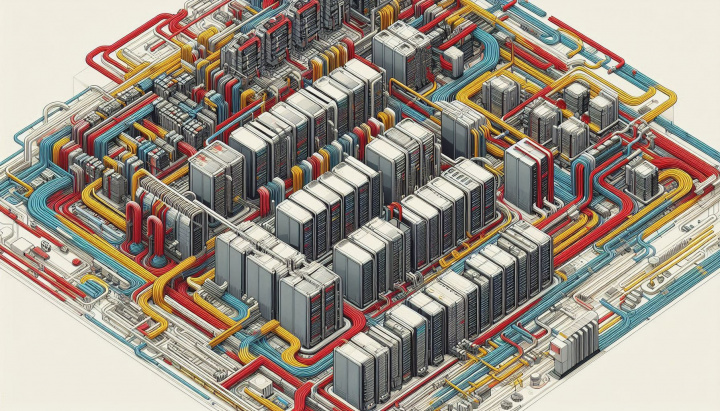Big Tech, AI, Energy: The Quest for Sustainability
As demand for artificial intelligence (AI) skyrockets, Big Tech companies face the immense challenge of powering their data centers without exacerbating climate change. Driven by the computational intensity of training and running complex models, AI's rapid growth is forcing a re-evaluation of energy sources, creating a delicate balance between developing renewable energy and relying on the immediate availability of fossil fuels. This tension highlights the broader impact of AI's energy footprint on global environmental goals and strains on local power grids.

The Energy Challenges of Data Centers and Big Tech's Response
The escalating energy demand of data centers, primarily driven by Big Tech firms, presents significant challenges in terms of cost, efficiency, and sustainability. These challenges are intensified by the increasing integration of resource-hungry technologies like artificial intelligence (AI) and cryptocurrency mining.
Rising Energy Costs: The cost of powering data centers is a primary concern for operators, with some facing annual price increases of up to 40%. This surge is partly due to the growing demand for computational power and the expansion of data center infrastructure needed to accommodate more advanced, power-hungry processors.
Power and Cooling Demands: Newer generation processors, especially evolving beyond older x86 architectures, are larger and more demanding, requiring more power and generating significantly more heat. This necessitates the adoption of advanced cooling solutions, such as liquid cooling and immersion systems, which are more effective but also more complex and costly to implement and maintain. Furthermore, the substantial water usage associated with some cooling methods adds another layer of environmental concern.
Sustainability Challenges: Achieving net-zero emissions and other Environmental, Social, and Governance (ESG) targets is becoming increasingly difficult for data centers reliant on traditional energy sources. The costs of Renewable Energy Certificates (RECs) and Power Purchase Agreements (PPAs) are rising alongside demand, compounded by rapid technological advancements and growing regulatory pressure demanding greener operations.
The Impact of AI and Cryptocurrencies: The integration of AI and cryptocurrencies is projected to potentially double the electricity consumption of data centers by 2026 compared to 2022 levels. AI, in particular, significantly boosts overall electricity demand due to its computational intensity for both training models and running inference tasks.
Geographical and Real Estate Constraints: The location of data centers impacts both energy access and real estate costs. Facilities in regions with limited power supply, strained grids, or high property values face additional operational hurdles that can hinder scalability and performance.
Strategies for Enhancing Energy Efficiency
Tech companies are actively pursuing strategies to enhance the energy efficiency of their AI operations, focusing on optimizing AI algorithms, adopting more efficient chip designs, and implementing advanced cooling systems. These efforts are crucial for mitigating the total energy consumption associated with AI technologies.
AI Algorithm Optimization: Companies are refining their AI algorithms to improve computational efficiency. Techniques like pruning, quantization, and knowledge distillation help reduce the required computational resources, thereby lowering energy consumption. These methods streamline AI models to perform tasks with minimal loss of accuracy and performance.
Efficient Chip Designs: Specialized AI chips, such as Google's Tensor Processing Units (TPUs) and NVIDIA's energy-efficient GPUs, represent a significant step towards reducing energy use. These chips are designed to handle specific AI workloads more efficiently than general-purpose processors, leading to substantial energy savings in data centers.
Advanced Cooling Systems: To manage the heat generated by high-performance computing, tech companies are investing in advanced cooling technologies. Liquid cooling and immersion cooling systems, for instance, manage heat more effectively than traditional air cooling, reducing the energy needed for cooling operations.
Hardware and Software Co-optimization: There is a growing emphasis on hardware and software co-optimization. This approach involves designing AI software and hardware concurrently to maximize performance and energy efficiency. By tailoring software algorithms to the hardware architecture, companies can achieve lower latency and higher throughput while minimizing energy consumption.
Innovative Cooling Solutions in Data Centers
Data centers, the critical hubs of digital operations, face significant challenges in managing the heat generated by high-density computing. Innovative cooling solutions are essential for maintaining operational efficiency, protecting equipment, and reducing environmental impact.
Direct-to-Chip Cooling: This method applies cooling solutions directly to the CPU or GPU, where the most heat is generated. By targeting the hottest components, this system can significantly improve cooling efficiency and reduce the overall energy required for cooling.
Two-Phase Immersion Cooling: In this approach, electronic components are submerged in a non-conductive fluid that changes from liquid to gas upon heating. This phase change efficiently absorbs and dissipates heat. Two-phase immersion cooling is highly effective and can handle very high heat loads, making it suitable for high-performance computing applications.
Microchannel Cooling: This technology uses microchannel heat exchangers that circulate coolant through very small channels. The small size of the channels increases the surface area in contact with the coolant, enhancing heat transfer efficiency. Microchannel cooling is particularly effective in tight spaces, such as densely packed data centers.
Calibrated Vectored Cooling (CVC): CVC combines liquid and air cooling, specifically directed to the hottest areas of a server. Advanced control algorithms optimize coolant temperature and flow rate, ensuring precise thermal management and improved system performance. This targeted approach helps manage heat loads effectively in high-density server environments.
Rear-Door Heat Exchanger (RDHx): RDHx systems use a heat exchanger mounted on the rear door of server racks. They can be passive, utilizing the server's internal fans, or active, with additional fans to enhance airflow. Heat absorbed by the liquid coolant in the coil is dissipated, efficiently removing heat directly at the source and reducing the cooling burden on the rest of the data center.
New Horizons in Energy Management: Amazon and Helion Energy
Amazon's initiative to build its own power plants represents a strategic move to secure energy supply and enhance the sustainability of its extensive data center network. By constructing power facilities, Amazon aims to reduce its dependence on external power grids, which is crucial given the high energy demands of large-scale data center operations. This initiative not only supports Amazon's goal of using 100% renewable energy by 2025 but also aligns with its broader commitment to achieving net-zero carbon emissions by 2040 under The Climate Pledge.
In parallel, Sam Altman's significant personal investment in Helion Energy marks a strategic push towards revolutionizing the energy landscape, particularly for powering data centers and AI technologies. With a $375 million personal investment, Altman is backing Helion's ambitious project to develop a nuclear fusion power plant, expected to be operational by 2028. This development not only signals momentum in the sustainable energy space but could position fusion energy as a potential cornerstone for meeting future energy needs in the tech industry.
The Future of Fusion Energy: A Solution for Big Tech's Energy Problems?
Before exploring its potential for Big Tech, it's helpful to understand what fusion energy is. In essence, fusion mimics the process that powers the sun, fusing light atomic nuclei (like hydrogen isotopes) together to form heavier ones, releasing immense amounts of energy in the process. Crucially, this process does not produce greenhouse gases and uses fuel sources (like deuterium from water and lithium) that are abundant.
Often hailed as a clean and virtually limitless source of power, fusion energy is emerging as a potential long-term solution to the energy challenges faced by Big Tech companies, especially for their power-hungry data centers. As these companies grapple with escalating energy demands driven by AI, fusion offers a compelling alternative.
Virtually Limitless Clean Energy: As mentioned, fusion power is clean, producing no greenhouse gas emissions. Its primary fuels are abundant, offering a potentially sustainable energy source for millennia.
Safety and Waste Advantages: Unlike traditional nuclear fission, which splits heavy atoms and can produce long-lived radioactive waste, fusion offers a safer alternative with significantly less and shorter-lived radioactive waste. The fusion process itself is inherently safer, without the risk of meltdown associated with fission reactors.
Big Tech Investments: Recognizing the potential of fusion energy, major tech companies have started investing in this technology. Google, for example, has invested in TAE Technologies, a leading fusion energy company. Microsoft has also shown interest, signing an agreement to purchase electricity from a fusion power plant once operational, signaling confidence in its future viability.
Technological Hurdles: Despite its promise, fusion energy is not yet commercially ready. The technology is still in the development stage, facing significant scientific and engineering challenges. These include achieving and sustaining the extremely high temperatures and pressures required for fusion reactions and creating a stable, contained environment for continuous energy production.
A Long-Term Solution: While fusion energy could eventually provide a sustainable and abundant power source for data centers, it is considered a long-term solution. Current projections suggest it may still take decades before fusion power is available at the scale and cost needed to be commercially viable.
Meeting the escalating energy demands of their data centers presents an increasingly complex challenge for Big Tech companies, especially amidst the rapid advancement of artificial intelligence. While they employ innovative cooling technologies and energy efficiency measures as short-to-medium-term strategies to align with sustainability goals, future breakthroughs like fusion energy offer the promise of a long-term solution. The coming years will be critical for optimizing energy resources, integrating new technologies, and navigating the delicate balance between powering computational progress and meeting global environmental responsibilities.





